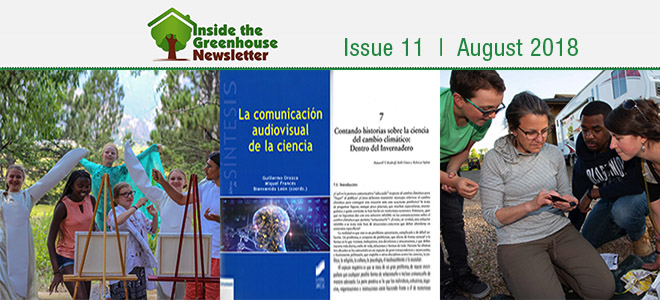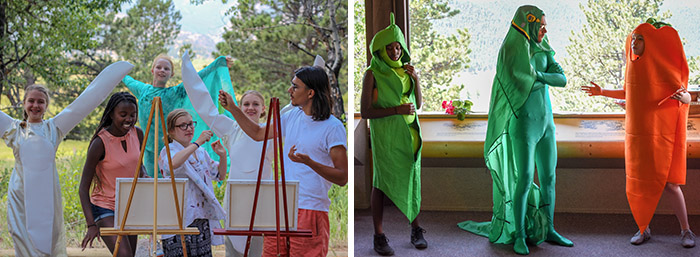
Issue 11 | May 2018
Subscribe to ITG Newsletters
We hope you’ve had a great summer. We’re excited to continue our programming into Fall after productive summer. We continue to engage in research and activities in in order to advance wider interdisciplinary academic communities to build capacity, competence and confidence in CU Boulder undergraduate and graduate student communicators with whom we primarily work. As we continue with these commitments to foster a deliberative space to co-create and analyze creative climate communications, we thank you for your ongoing support.
Please continue your support by visiting the Inside the Greenhouse Gift Fund to provide a tax-deductible gift. We are grateful for contributions in any amount.
Warm regards,
Rebecca Safran, Beth Osnes and Max Boykoff
(Inside the Greenhouse co-directors)
RESEARCH NOTE
Max Boykoff, Beth Osnes and Rebecca Safran recently published research in a Spanish-language volume on ‘Audiovisual Communication of Science’, edited by Guillermo Orozco, Miquel Francés and Bienvenido León. (‘Comunicación Audiovisual de la Ciencia’). The chapter is titled ‘Telling Stories about the Science of Climate Change: Inside the Greenhouse’ (‘Contando historias sobre la ciencia del cambio climático: Dentro del Invernadero’). The chapter features research into the efficacy of work that Inside the Greenhouse has done with the More than Scientists project over the past three years.
The main sections of this book are:
- genres and media formats in scientific communication
- narrative strategies in audiovisual realization and production of scientific content
- scientific communication in the digital multicast video online
- quality and scientific rigor in the audiovisual dissemination of science
This research output emanates from collaborations that Max Boykoff has been involved in with TVMorfosis. The group met in June 2017 in Valencia, Spain as part of ongoing work on science communication for Spanish-language audiences in Brazil, Mexico, Costa Rica, Argentina, Colombia and Uruguay.
COURSE SPOTLIGHT
The Art of Science Communication
Coming up in Spring 2019, Rebecca Safran (Associate Professor, Ecology and Evolutionary Biology) and Erin Schauster (Assistant Professor, Advertising, Public Relations, Media Design) will co-teach a new course during the Spring 2019 term titled ‘The Art of Science Communication’.
This cross-disciplinary course is an evolved version of the Film and Climate Change class (taught each Fall by Rebecca Safran for the past nine years). This new course will integrate the science of climate change and science communication with the science of advertising, public relations, and media design. This class will be designed for early undergraduate students, with an enrollment cap of 40 students.
The basic premise is this: Students of advertising require the most concise visual storytelling toolkits in order to sell brands and products. Scientists working on the multi-dimensional problem of climate change require facts to anchor policy and conservation initiatives but often lack the communication skills required to relate to the public. Therein lies a huge gap: the issues of climate change science are more pressing than ever yet reaching the public has largely failed. How do we turn abstract, scientific facts into compelling visual stories that reach people across all political and socio-economic walks of life? The course will address this hugely pressing and timely question through a cross-disciplinary engagement focused on creating ads for the planet.
EVENT HIGHLIGHT
Drawdown Act Up

Set against a backdrop of the Rocky Mountains, Inside the Greenhouse premiered its latest performance-based project that features Grandmother Refrigerator, singing wind turbines, and a very hungry caterpillar. Drawdown Act Up leads participants in embodied youth engagement in climate solutions. Participatory activities and games physicalize the science behind a Drawdown climate solution, and the accompanying funny skit contextualizes the solution and cleverly demonstrates how to activate that solution locally in daily life.
This July, families visiting the Discovery Center of Rocky Mountain National Park joined in the activities and enjoyed the brief performances that dramatized the importance of properly recycling of aged refrigerators, the beauty of wind turbines, and how to reduce food waste. Many were surprised to learn that these skits were each based on the three top solutions for drawing down carbon to reverse global warming.
To maximize impact, Inside the Greenhouse focused artistic expression on the most impactful solutions identified by Drawdown’s team of researchers who generated a list of top solutionsfor reversing global warming.
Piloting this project in a US National Park was a continuation of Inside the Greenhouse association with the National Park Service Climate Response Team. This project was designed to encourage, invigorate and maximize commitment to environmental stewardship among visitors to US National Parks through Drawdown Act Up activities.
This October, ITG co-founder, Beth Osnes, will be sharing this work at the Drawdown conference, “Drawdown Learn: Teaching a Solutions-Based Approach to Climate Change,” at the Omega Institute in New York. Students in the Spring 2018 Creative Climate Communication course developed compositions to help cultivate material for this project. In the coming year ITG will continue to research how engagement in this project can contribute to student learning and effectively communicate climate solutions.

